Enhanced Redundant Residue Number System Codes for Reliable Diffusive Molecular Communication
IF 4.4
4区 生物学
Q1 BIOCHEMICAL RESEARCH METHODS
引用次数: 0
Abstract
This paper introduces an improved redundant residue number system (RRNS) encoding method to enhance the reliability of information transmission in diffusive molecular communication (DMC). In addressing the 2-1 mapping issue in RRNS encoding, we propose a simplified low-mapping solution that effectively avoids the 2-1 mapping problem, thereby simplifying the decoding process. Leveraging the superior performance of the low-mapping algorithm, we further developed a direct decision algorithm that further simplifies the decoding algorithm by omitting the traditional minimum distance decision-making steps. Furthermore, this study delves into the impact of modulus selection on RRNS decoding performance and provides guidelines for optimizing code construction. Through simulation experiments on DMC channels, we have validated the effectiveness of the proposed RRNS encoding method, especially when employing binary concentration shift keying (BCSK) modulation and considering intersymbol interference (ISI). The simulation results show that the proposed encoding method not only significantly reduces the bit error rate (BER) but also fully meets the requirements of DMC systems, offering a promising new direction for the development of molecular communication technology. With these improvements, our method not only enhances the reliability of information transmission in DMC systems but also lays a solid foundation for future research and applications in molecular communication technology.可靠扩散分子通信的增强型冗余数系统码。
为了提高扩散分子通信(DMC)中信息传输的可靠性,提出了一种改进的冗余数系统(RRNS)编码方法。针对RRNS编码中的2-1映射问题,我们提出了一种简化的低映射方案,有效地避免了2-1映射问题,从而简化了解码过程。利用低映射算法的优越性能,我们进一步开发了直接决策算法,省去了传统的最小距离决策步骤,进一步简化了解码算法。此外,本研究还探讨了模量选择对RRNS解码性能的影响,并为优化编码结构提供指导。通过在DMC信道上的仿真实验,我们验证了RRNS编码方法的有效性,特别是在采用二进制集中移位键控(BCSK)调制和考虑码间干扰(ISI)时。仿真结果表明,所提出的编码方法不仅显著降低了误码率(BER),而且完全满足DMC系统的要求,为分子通信技术的发展提供了一个有希望的新方向。通过这些改进,我们的方法不仅提高了DMC系统中信息传输的可靠性,而且为未来分子通信技术的研究和应用奠定了坚实的基础。
本文章由计算机程序翻译,如有差异,请以英文原文为准。
求助全文
约1分钟内获得全文
求助全文
来源期刊

IEEE Transactions on NanoBioscience
工程技术-纳米科技
CiteScore
7.00
自引率
5.10%
发文量
197
审稿时长
>12 weeks
期刊介绍:
The IEEE Transactions on NanoBioscience reports on original, innovative and interdisciplinary work on all aspects of molecular systems, cellular systems, and tissues (including molecular electronics). Topics covered in the journal focus on a broad spectrum of aspects, both on foundations and on applications. Specifically, methods and techniques, experimental aspects, design and implementation, instrumentation and laboratory equipment, clinical aspects, hardware and software data acquisition and analysis and computer based modelling are covered (based on traditional or high performance computing - parallel computers or computer networks).
 求助内容:
求助内容: 应助结果提醒方式:
应助结果提醒方式:


